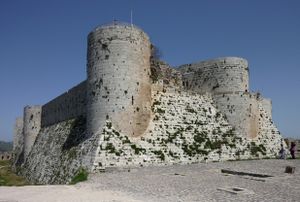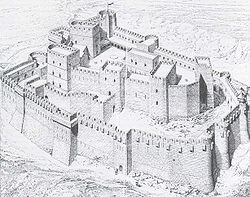Krak des Chevaliers
| Krak des Chevaliers قلعة الحصن |
|
|---|---|
| Near Hims, Syria | |
 Krak des Chevaliers from the South-West |
|
| Type | Castle |
| Built | 1031 and from 1150–1250 |
| Construction materials |
Limestone |
| Current condition |
Partly ruined |
| Open to the public |
Yes
|
| Crac des Chevaliers and Qal’at Salah El-Din* |
|
|---|---|
| UNESCO World Heritage Site | |
 |
|
| State Party | |
| Type | Cultural |
| Criteria | ii, iv |
| Reference | 1229 |
| Region** | List of World Heritage Sites in the Arab States |
| Inscription history | |
| Inscription | 2006 (30th Session) |
| * Name as inscribed on World Heritage List. ** Region as classified by UNESCO. |
|
Krak des Chevaliers (French pronunciation: [kʁak de ʃəvaˈlje]), transliterated Crac des Chevaliers, is a Crusader fortress in Syria and one of the most important preserved medieval military castles in the world. In Arabic, the fortress is called Qal'at al-Ḥiṣn (Arabic: قلعة الحصن), the word Krak coming from the Syriac karak, meaning fortress. It is located approximately 40 km west of the city of Homs, close to the border of Lebanon, and is administratively part of the Homs Governorate.
Contents |
Etymology
Known to the Arabs as Hisn al Akrad (Arabic: حصن الأکراد), the Castle of the Kurds, it was called by the Franks Le Crat and then by a confusion with karak (fortress), Le Crac.[1]
Location
The castle is located east of Tripoli, Lebanon, in the Homs Gap, atop a 650-metre-high hill along the only route from Antioch to Beirut and the Mediterranean Sea. It is one of many fortresses that were part of a defensive network along the border of the old Crusader states. The fortress controlled the road to the Mediterranean, and from this base, the Hospitallers could exert some influence over Lake Homs to the east to control the fishing industry and watch for Muslim armies gathering in Syria.
History

The original fortress at this location had been built in 1031 for the emir of Aleppo.
During the First Crusade in 1099 it was captured by Raymond IV of Toulouse, but then abandoned when the Crusaders continued their march towards Jerusalem. It was reoccupied again by Tancred, Prince of Galilee in 1110. In 1142 it was given by Raymond II, count of Tripoli, to the Hospitallers, contemporaries of the Knights Templar.
Krak des Chevaliers was the headquarters of the Knights Hospitaller during the Crusades. It was expanded between 1150 and 1250 and eventually housed a garrison of 2,000.
In 1163 the fortress was unsuccessfully besieged by Nur ad-Din Zengi, after which the Hospitallers became an essentially independent force on the Tripolitanian frontier. By 1170 the Hospitallers' modifications were complete. In the late 12th and early 13th century numerous earthquakes caused some damage and required further rebuilding.
Saladin unsuccessfully besieged the castle in 1188. During the siege the castellan was captured and taken by Saladin's men to the castle gates where he was told to order the gates opened. He reportedly told his men in Arabic, the language of his captors, to surrender the castle, but then told them in French to hold the castle to the last man.
In 1217, during the Fifth Crusade, king Andrew II of Hungary strengthened the outer walls and financed the guarding troops. In 1271 the fortress was captured by Mamluk Sultan Baibars on April 8 with the aid of heavy trebuchets and mangonels, at least one of which was later used to attack Acre in 1291. However, to conquer the castle, Baibars used a trick, by presenting a forged letter from the Crusader Commander in Tripoli, ordering the defenders to surrender the castle. Otherwise, this immensely strong castle would probably never have fallen. Baibars refortified the castle and used it as a base against Tripoli. He also converted the Hospitaller chapel to a mosque.
Architecture


The fortress was described as “perhaps the best preserved and most wholly admirable castle in the world” by T. E. Lawrence.[2][3] In 1935, the castle was bought by the French government. Restoration began under the supervision of Pierre Coupel, who had undertaken similar work at the Tower of the Lions and the two castles at Sidon.[4] The castle was made a World Heritage Site, along with Qal’at Salah El-Din, in 2006,[5] and is owned by the Syrian government. The fortress is one of the few sites where Crusader art (in the form of frescoes) has been preserved.
The Hospitallers rebuilt it and expanded it into the largest Crusader fortress in the Holy Land, adding an outer wall three meters thick with seven guard towers eight to ten meters thick to create a concentric castle. The fortress may have held about 50–60 Hospitaller knights and up to 2,000 other foot soldiers; the Grand Master of the Hospitallers lived in one of the towers.
The buildings in the inner ward were rebuilt by the Hospitallers in a Gothic style. These buildings included a meeting hall, a chapel, a 120-meter-long storage facility, and two vaulted stone stables which could have held up to a thousand horses. Other storage facilities were dug into the cliff below the fortress; it is estimated that the Hospitallers could have withstood a siege for five years.
Crac can be classified both as a spur castle and a fully developed concentric castle. The southern side of the castle is the most vulnerable to attack, as this is where the spur on which the castle stands is connected to the next hill, so that siege engines can approach on level ground. The inner defences are strongest at this point, with a cluster of towers connected by a thick wall. The inner curtain wall is up to 100 feet thick at the base on the south side, with seven guard towers 30 feet in diameter. The bottoms of the walls are reinforced with a talus. Between the inner and outer walls at the southern side there is a large open cistern, fed by an aqueduct from outside the castle. The square tower in the South does not date from the crusader period, but was added when the Mamluks repaired the damage from their successful siege after they had taken over the castle.
On the eastern side between the inner and outer walls a vaulted ramp leads from the outer to the inner gate. The ramp makes a number of elbow turns and is defended by arrow slits and machicolations, making it a strongly defended bent entrance. On the northern side, there is a postern gate flanked by two towers. On the Western side, the ward between the outer and inner walls does not contain any buildings, but it is here that the concentric principle of defence is most evident, with the inner defences completely dominating the outer wall. The walls on all sides contain passages that act as shooting galleries or vaults leading to arrow slits.
References
- Notes
- ↑ Setton, Kenneth M.; Hazard, Harry W. (1977), A History of the Crusades: The Art And Architecture of the Crusader, Madison: University of Wisconsin Press, p. 152, ISBN 0299068242.
- ↑ Cite error: Invalid
<ref>tag; no text was provided for refs namedHC - ↑ Krak des Chevaliers - Crusader Castle in Syria
- ↑ Albright 1936, p. 167
- ↑ UNESCO list
- Bibliography
- Albright, W. F. (1936), "Archaeological Exploration and Excavation in Palestine and Syria, 1935", American Journal of Archaeology (Archaeological Institute of America) 40 (1): 154–167, http://www.jstor.org/stable/498307
Further reading
- Folda, Jaroslav; French, Pamela (1982), "Crusader Frescoes at Crac des Chevaliers and Marqab Castle", Dumbarton Oaks Papers (Dumbarton Oaks, Trustees for Harvard University) 36: 177–210, http://www.jstor.org/stable/1291467
- Smail, R. C. (1973), The Crusaders in Syria and the Holy Land, London: Thames and Hudson, ISBN 0-500-02080-9
External links
- A Medieval Castle in the Middle East, The Wall Street Journal, January 31, 2009
- Picture tour through castle
|
|||||